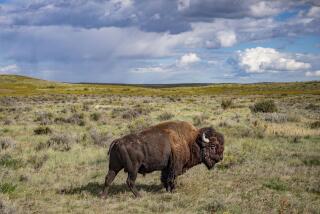A stampede of TNT bucks
- Share via
When TNT started calling itself the network that “knows drama” four years ago, it set a course that will culminate June 10 with the debut of “Into the West”-- a big, expensive original miniseries the network hopes will be the Great Buffalo of summer television.
In six two-hour episodes, the multigenerational saga covers seven decades and follows two families, the wheel-making Wheelers who leave Wheelerton, Va., to become pioneers across the Mississippi, and a Lakota family whose clan loses almost everything to the obsession of people like the Wheelers. TNT lured Steven Spielberg as executive producer, then spent $50 million making the project in Canada and New Mexico -- and another, unheard of, $50 million promoting it.
“It’s the most comprehensive marketing we’ve ever done, and probably the most comprehensive in the history of television,” said Steven R. Koonin, the Atlanta, Ga.-based executive vice president and chief operating officer of TBS and Turner Network Television (TNT).
Throngs of viewers and critical success would be nice. But what the network really wants from “Into the West” is a strong identity in the minds of viewers, something it has yet to cement. Because one show can shift the balance of an entire network, ad-supported cable channels such as TNT are now scrambling to find their own “Queer Eye” or “Nip/Tuck,” to name two shows that almost single-handedly transformed the image of their channels -- Bravo and FX, respectively -- from cable backwater to big-league cable player.
As local producer Paul Jackson, board member of the National Assn. of Television Program Executives, put it, “We’re at the point where a lot of cable operators are saying we can actually turn around a whole operation on the back of as little as one or two shows. They’re saying to their creative buyers, ‘Get out in the marketplace, don’t be afraid to bring back challenging proposals for a network-defining show.’ ” And they’re willing to spend money to let people know about it.
To find an audience for “Into the West,” Koonin said, TNT targeted magazine, radio, TV and newspaper ads to six groups, chosen by psychographics, which focuses on mind-sets, just as demographics looks at age and income.
Advertising was directed at the family-saga lovers, a category that includes women 25 and older; action seekers, men 18 to 49; history buffs, men 35 and older; western lovers, people who love the beauty of the Old West, men 25 and older. In addition, they’ve also targeted “truth seekers,” adults 25 and older who will like the dual narrative with both sides fairly depicted; and “Generation ‘whY,’ people 18 to 34 who need a reason to watch.
The enormous media kits for “Into the West” arrived in weathered leather-stitched-and-stamped binders. The cast and crew gave interviews to 22 afternoon-drive disc jockeys gathered by TNT in Jackson Hole, Wyo. More than 100,000 buffalo nickels will be given away on the streets of major cities. Singer Sarah McLachlan remade her song “World on Fire” for a video marketed to young women.
The seeds for the extravaganza were sown four years ago when TNT sought to engage viewers who like not only sports but also “stuff that makes you think and feel,” according to Michael Wright, who oversees the network’s original programming from his glass-walled office in Burbank. That mission, marked at first by “Law & Order” reruns and NBA playoffs, grew to embrace original programming when Wright was hired a year later.
Wright said he first drew up a wish list of filmmakers, writers and directors who could best promote TNT’s designated brand. Spielberg’s name topped the list. Along with Tom Hanks, Spielberg reinvigorated the TV miniseries in 2001 with the WWII saga “Band of Brothers,” Wright said. DreamWorks Television, the network television production arm of Spielberg’s DreamWorks SKG, also produced last year’s Emmy-winning alien-abduction miniseries, “Taken.”
*
‘Commercial but smart’
“Their tastes run to what our tastes aspire to: commercial but smart,” Wright said. “We’re not the homework channel or the civics-lesson channel. We’re the entertainment network. We want to entertain but be as smart as we can.”
Wright said he approached Spielberg and DreamWorks with the idea to “tell a comprehensive, up-to-the-minute story ... and tell as authentic a tale as we can about the opening of the American West.
“His inspiration was to tell it from both sides.” Spielberg was unavailable for comment.
Wright said Spielberg was heavily involved in production, providing not only his name but also his creative talents. Spielberg chose the cast, the head writer and the six directors, gave pages of single-spaced notes on the rushes, and even consulted on marketing. Spielberg insisted on having Native American characters speak the language of their tribe, which required the script to be translated into Lakota and other languages, taught to the actors, and then restored to English for the subtitles.
Following Spielberg tradition, “Into the West” aims to achieve a multitude of other expansive, high-minded goals as it spins its tale of the two families. “One of the first things Steven said was, ‘I want this in every school in America,’ ” said Darryl Frank, who along with Justin Falvey heads DreamWorks Television, where they oversee all series development and long-form programming for the studio. “ ‘Students can learn about the American West in our show but not know they’re being taught.’ ”
Koonin said 18,000 packets including DVDs and teaching materials will be sent to public and private high schools across the country in time for the fall semester. The gesture was not meant as a comment on how schools teach history, he said. But “not only do we think [the show is] a great piece of entertainment, we think it serves a useful purpose of helping people learn more about multiple cultures and interactions between people,” he said.
Co-executive producer and head writer William Mastrosimone (“Sinatra,” “The Burning Season”) said that after three weeks of research, he was inspired in a dream to build the series around two contrasting wheel symbols: the utilitarian wagon wheel of progress, and the cultural and religious medicine wheel that represents an unchanging connection to the land. After he was subsequently hired, he created the characters of Jacob Wheeler and Loved by the Buffalo, whose families each contain heroes and villains and crisscross over the course of 70 years. The fictional characters also encounter historical characters along the way in violent events such as the Sand Creek Massacre, Little Big Horn and Wounded Knee.
On the American side, Mastrosimone said some of his goals were to depict the high ideals and perilous shortcomings of the American character as described by the 19th century French writer Alexis de Tocqueville, and to dramatize the very American ideas of progress and Manifest Destiny. On the Indian side, he said he wanted to improve the public’s understanding of the plight of Indian families in the same way the 1977 miniseries “Roots” expanded awareness of the lives of black families under slavery.
He said he was astonished to learn what happened to the culture of the tribes of the Plains. “One hundred thirty-five years ago, we had a veritable Serengeti Plains with 40- to 60-million buffalo,” he said. “We all know the buffalo were decimated. We think that’s why the Indians vanished.” But more than a food source, the animals’ bones and hides were used as bowls, tools and painting surfaces; they inspired prayers, dances and sacrifices. The series shows how the culture gradually disappeared, bit by bit, like the buffalo, he said.
While the series relied heavily on several Native American consultants, a response from Native American communities not associated with the production has yet to be heard.
*
Get them talking
Regardless of what potential critics will say, and despite the network’s massive promotion, the executives say they will be happy if even the most mundane goals for the series are met. Wright said that, as with any original programming, one aim is simply to get people talking about “Into the West.” Strategically, the miniseries will serve as the vanguard of TNT’s latest crop of original programming, which includes the new series “The Closer” and “Wanted,” both cop dramas set in L.A. “We plan to use ‘Into the West’ to leverage the audience for ‘The Closer,’ ” which debuts after “Into the West” begins, Koonin said.
Wright said he isn’t going to hold his breath for the critical jury to weigh in.
“You can make really great television and nobody shows up. You can make really bad television and everybody shows up. I hope the world shows up, so much good work went into this. On that measure alone, they gave their all on this and I think it shows on the screen. And I want Turner to be rewarded for stepping out and trying to do something that is not filler.”
More to Read
The biggest entertainment stories
Get our big stories about Hollywood, film, television, music, arts, culture and more right in your inbox as soon as they publish.
You may occasionally receive promotional content from the Los Angeles Times.










